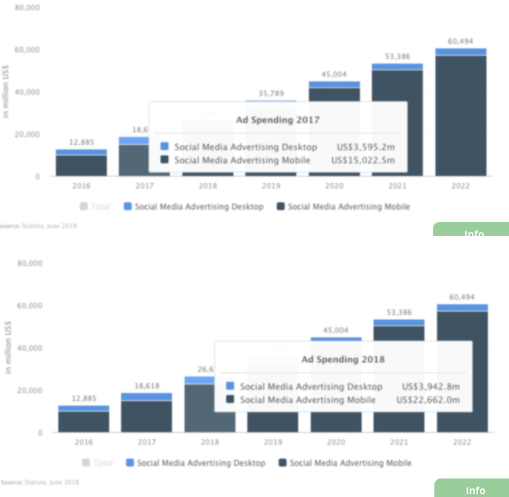Around this time last year, the Image in a Box team was thinking of digital marketing trends we thought we'd see in 2018. Now we're seeing if those predictions came true and how they will continue to evolve. Check out how these 4 digital marketing trends played out this year.
Jacob's 2018 Digital Marketing Prediction:
WordPress usage will encompass 32-35% of all sites and WordPress market share will encompass 62-65% of all CMS' by the end of 2018.
The Results:
Jacob's prediction had two parts and he was right about the first half, Wordpress encompassing 32-35% of all websites. However, his prediction about Wordpress' market share didn't come true.
As of right now, WordPress usage currently encompasses 32.3% of all sites, while its market share only encompasses 59.4%. Jacob anticipated WordPress to take a larger market share, but other content management systems (CMS) also saw growth this year, which was enough to outpace Wordpress' market share growth.
As for what he thinks will happen in 2019, Jacob believes that Wordpress usage as a whole will continue to rise, especially with the release of Gutenberg. However, since Wordpress isn't the only CMS to be experiencing growth, he says we'll just have to wait and see about the market share.
Jasmine's 2018 Digital Marketing Prediction:
Videos and podcasts will become an increasingly popular way of presenting and distributing content in 2018.
The Results:
Jasmine's prediction was right! Both videos and podcasts are becoming prominent in the content world.
Recent studies show that monthly podcast listeners increased from 24% to 26% over the last year, and that weekly listeners increased from 15% to 17%. Another study shows that when both video and text are available on the same page, that 72% of people would rather use video to learn about a product or service.
It's not surprising to see videos became more popular this year since 65% of companies who didn't use videos in their content marketing strategy in 2017, planned to in 2018. We are always looking for ways to simplify things, and videos and podcasts are easier ways to consume information.
With that said, Jasmine predicts that videos and podcasts will continue to be popular ways to distribute content. In fact, Cisco released a forecast that predicts IP video traffic will be 82% of all consumer internet traffic in 2021.
Justin's 2018 Digital Marketing Prediction:
Website tracking by cookies and analytics will become harder in 2018.
The Results:
Justin's prediction was right because of the General Data Privacy Regulation (GDPR) that went into place this year. Because of this, so many websites had to enable cookie banners and notifications. Specifically in the EU, you aren't allowed to track without getting consent from the user. If your website is heavy in the EU or even internationally, you have to implement the right software and provide ways for the end user to retrieve their data.
So how does all of this make website tracking harder? For starters, you might see a huge uptick in "New Users" in your analytics platforms because users decline the consent form, which makes the data less reliable. This also affects A/B testing, since most platforms use cookies to help test different variants of copy or styling on a page.
The result of the GDPR affecting website analytics isn't surprising. If anything, it at least opened a new line of business for consent platforms. Justin sees this trend continuing on through the years, until the internet is revamped. He wouldn't be surprised to see more countries added in similar laws like the EU did around cookies and tracking.
Michelle's 2018 Digital Marketing Prediction:
In 2018, pay-to-play online will become necessary for all stages of the buyer's journey.
The Results:
Michelle's prediction wasn't easy to inconclusively determine if it was right or wrong. However, research shows that she is more right than she is wrong.
Despite major privacy concerns that were unveiled, specifically from Facebook, social advertising still grew tremendously in 2018. It's possible that this growth caused a shift of where buyers are in the journey when they begin searching for your product/service because they no longer have to search for initial answers to solve their problems.

Due to all the scrutiny Facebook received, some of their targeting capabilities have been limited or removed. Even with these limitations, you're still able to target high-qualified potential customers that need your product/service before they even know a true solution like yours exists.
This type of targeting has the potential to disrupt how people search for your product or service on Google, which ultimately changes where the potential customer is in the buyer's journey when they actually begin searching on Google. Due to this disruption, pay-to-play is necessary for content promotion to each stage of the buyer's journey, including awareness stage blog content.
Although it doesn't appear that there were more Search Engine Result Pages (SERPs) features added by Google in 2018, the 2017 changes set up this year to be a SERP-focused year for SEOs. What that means for your website's ranking on SERPs is that now more sites are optimized for SERP features, which just makes more of those features appear on the first page of the Google search results. So it is safe to say that SERP features are making pay-to-play more necessary to rank highly on the first page for competitive keywords.
The research isn't surprising because tech giants continue to find ways to maximize revenue through advertising. This makes pay-to-play the most effective way for marketers to reach potential customers within their platform. Michelle predicts that both social media advertising and SERP features reach will only increase for the short term, making pay-to-play a necessity in content strategies for all stages of the buyer's journey.
Well there you have it! Those were the results of what we predicted would happen in the digital marketing realm in 2018. Stay tuned to see what we predict to see in 2019!

